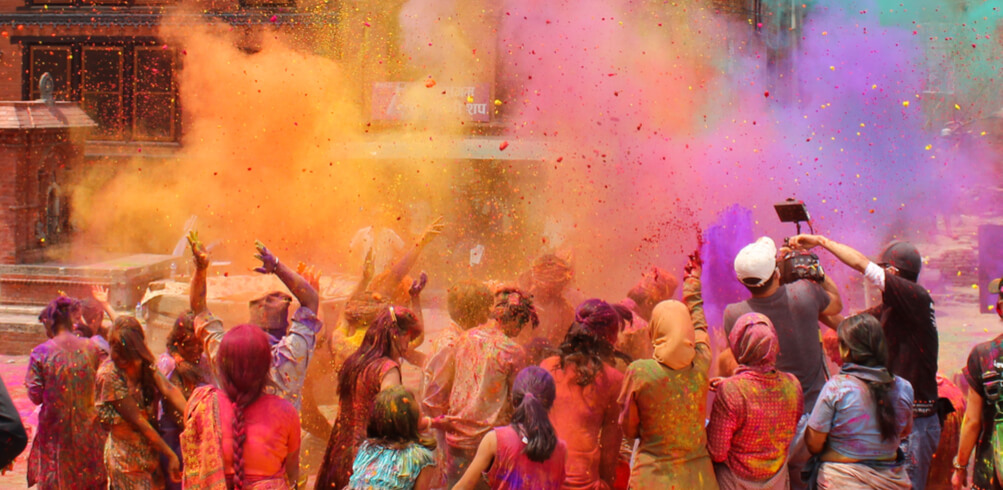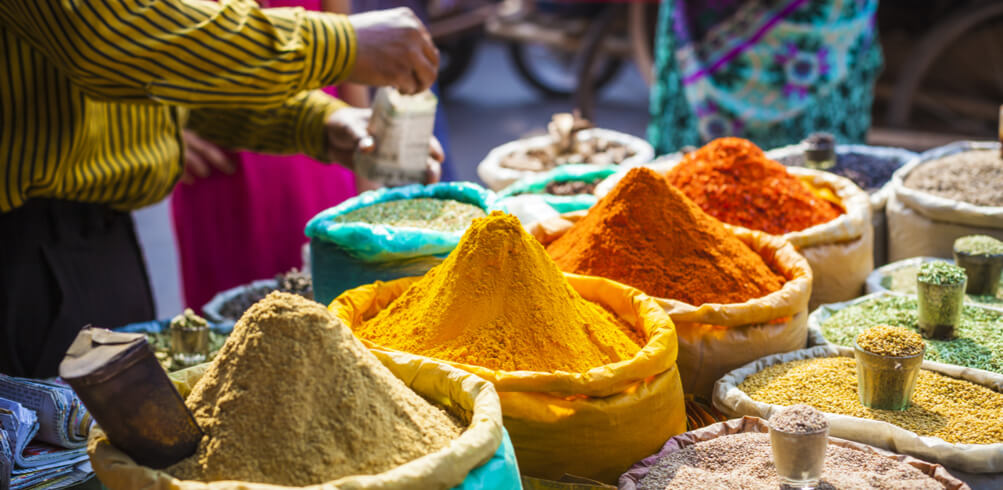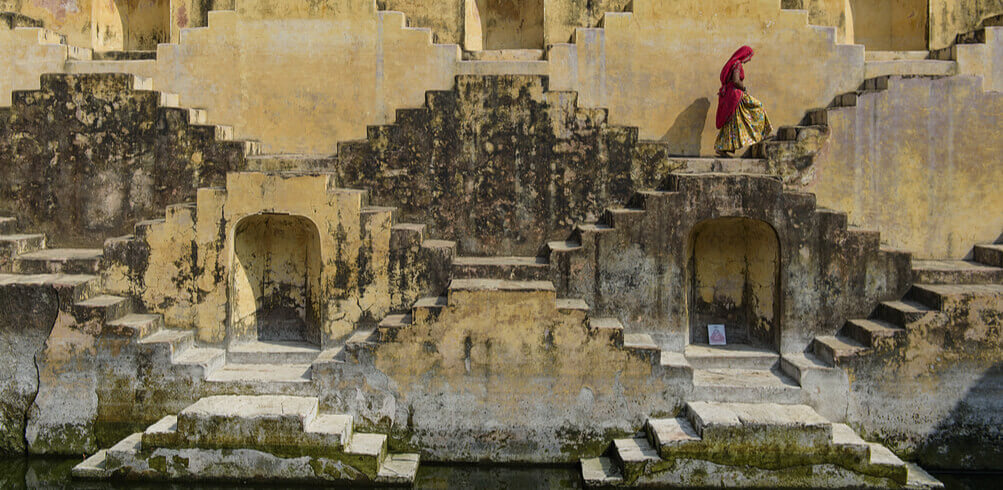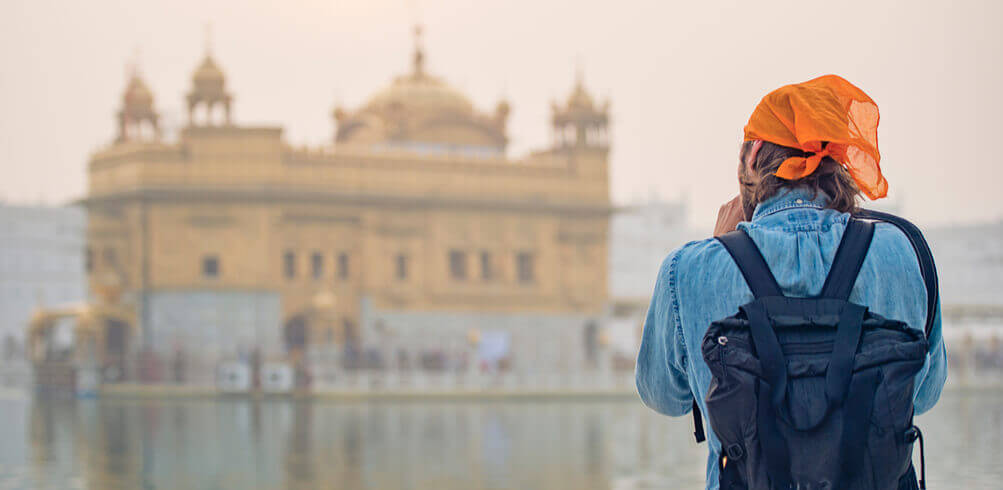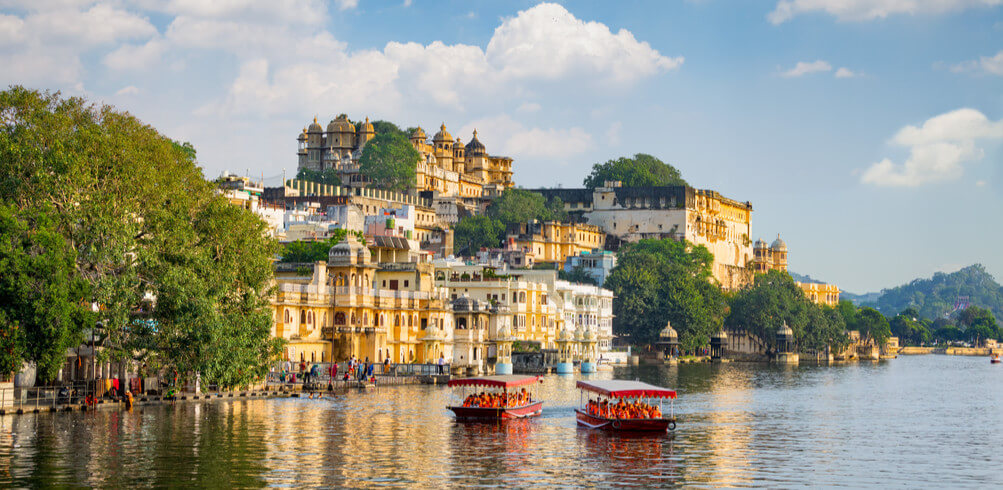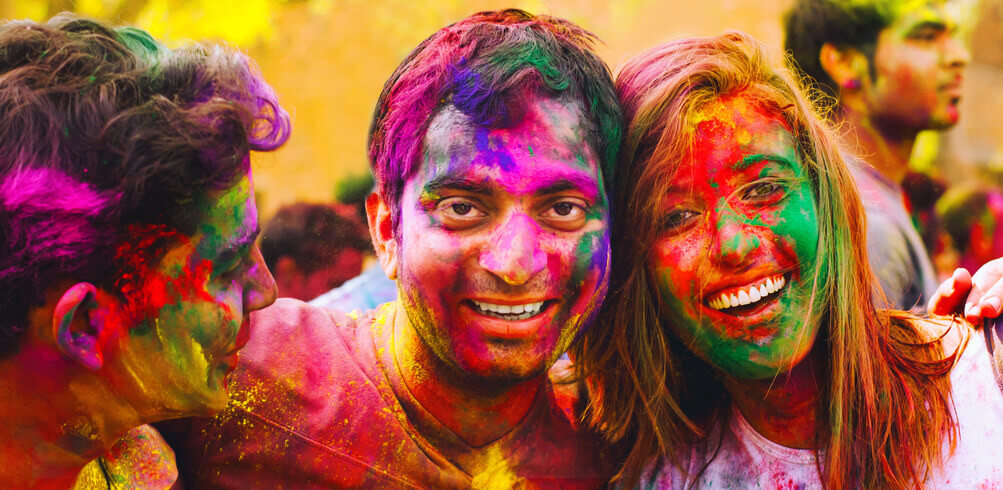India: a land of vibrance and colour, of rich heritage and unexpected delights. It’s a country that takes its celebrations as seriously as its worship and has great pride in its gastronomy. Step off the plane and prepare for a sensory overload: blaring car horns, lively markets, and aromatic spices that tickle your nose.
Between its delicious cuisine, varying by region and season, and its phenomenal ancient structures – the Taj Mahal and the Amer Fort to name just two – India offers something for every inspired traveller. And whether you dream of wandering the pink streets of Jaipur, or watching a sunrise wash over the Ganges in sacred Varanasi, India will grip you with full force and refuse to let go. Click here to learn more about when is the best time to visit India.
We offer a range of India tours to match different travel styles and interests. You can choose from our comprehensive Classic tours featuring must-see destinations, intimate Small Group tours for a more personal experience, custom Private tours, Tailor-made tours designed just for you, or flexible Independent Tours.
Our India tour packages span anywhere from 7 to 28 days, offering a broad range of unforgettable experiences—whether you dream of exploring the iconic Golden Triangle or unwinding in the serene backwaters of Kerala. With so many diverse itineraries to choose from, you’ll find the journey that perfectly fits your travel style.
Our Classic Indian group tours generally accommodate 8-20 travellers, combining all the must-see highlights with unbeatable value—perfect for experiencing India's magic without the premium price tag.
Travelling on our Small Group Tours, you’ll enjoy smaller groups of just 2-16 participants. These thoughtfully sized small groups give you the perfect mix of social connection and individual attention: large enough to meet interesting fellow travellers but small enough that our local guides can provide personalised insights.
When you book our tours to India, your package includes carefully chosen accommodation, daily breakfast and selected meals, all transportation within India (including internal flights where listed), admission to attractions included in your itinerary, experienced English-speaking guides, and all tipping for drivers and guides.
Many tours also feature exclusive Inspiring Sights and Inspiring Tastes experiences that go beyond typical tourist activities. While international flights aren't included, we're happy to arrange these for you when booking, or you can opt to book them yourself using our intuitive Flight Portal.
Food is a highlight of any India travel experience. Daily breakfast is included, along with select meals mentioned in your itinerary. Your guide will recommend trustworthy local restaurants for other meals, giving you the freedom to explore India's incredible culinary landscape.
Our Inspiring Tastes experiences might include anything from a home-cooked meal with a local family to a street food tour with an expert who knows exactly which stalls are both authentic and safe. Don't worry if you don't handle spice well—there are plenty of milder options available, and vegetarians will find themselves in paradise with India's incredible meat-free dishes.
Our guided tours of India balance structured activities with personal exploration time. We include the must-see attractions and unique experiences in each destination, but we also understand you might want to shop for textiles in Jaipur's markets, get an Ayurvedic massage in Kerala, or simply sit in a café watching the world go by. Your tour guide can suggest additional activities during free time based on your interests, whether that's finding the best local crafts, photographing hidden gems, or discovering the perfect chai stall.
Our group tours to India use a mix of transportation methods to make your journey comfortable and efficient. For longer distances, we typically use domestic flights to maximise your time at destinations rather than on the road. For shorter journeys, you'll travel in air-conditioned vehicles suited to your group size.
Some tours include unique transportation experiences like heritage train journeys, rickshaw rides through Old Delhi, or boat cruises on the Ganges or Kerala's backwaters. All transportation mentioned in your itinerary is included in your tour price, and we handle all the logistics so you can simply enjoy the journey.
India's size means the ideal time for tours in India varies by region. For most of Northern India, including Delhi, Agra, and Rajasthan, the most comfortable months are October to March, when days are sunny but not scorching.
Southern India is generally best from November to February when humidity levels drop. Try to avoid the monsoon season (June to September) in most regions, when heavy rainfall can affect your experience.
If you're heading to the Himalayan regions, May to June offers stunning mountain views before the monsoon, while September to October brings clear skies after the rains. For detailed seasonal advice, check out our guide to the best time to visit India.
Smart packing makes a huge difference for your India holidays. For clothing, think "modest but comfortable"—lightweight pants, below-knee skirts/dresses, and tops that cover your shoulders will keep you cool while respecting local customs.
A scarf or shawl is invaluable for women to cover their heads and shoulders at certain religious sites. Comfortable walking shoes are essential as you'll be exploring lots of temples and historical sites, and you’ll often need to slip them off at the temples. Don't forget a hat, sunglasses, high-SPF sunscreen, hand sanitiser, and toilet paper for public bathrooms.
India uses 230V electricity with Type C, D, and M sockets, so bring a universal adapter. For a detailed seasonal packing list, see what to pack for your trip to India.
The Indian Rupee (INR) is very challenging to obtain outside India, so plan to exchange money upon arrival at airports or hotels (which offer convenience but not always the best rates) or at authorised banks and currency exchanges. ATMs are widely available in cities and tourist areas, though it's wise to carry some cash, especially when venturing into smaller towns.
Credit cards are accepted at hotels, upscale restaurants, and larger shops, but smaller vendors and markets only take cash. Let your bank know about your travel plans before departure to prevent card blocking. Keep small bills handy for tipping, street food, and market purchases – breaking large notes can be challenging with small vendors.
Understanding a few key customs will enrich your India travel experience.
As mentioned in our first-timers guide to India, a smile and patient attitude go a long way in navigating cultural differences.
A few simple precautions will help keep you healthy during tour of India. The golden rule is "boil it, cook it, peel it, or forget it."
Our guides are experienced in helping travellers stay healthy and can direct you to reliable medical help if needed.
Depending on your chosen itinerary, you might witness the mesmerising aarti ceremony on the Ganges with hundreds of flickering lamps illuminating the river at dusk, enjoy a homestay cooking experience to discover authentic Indian cuisine or wake early for a peaceful sunrise boat ride along Varanasi's ancient ghats.
Selected tours feature overnight stays in converted palace hotels, wildlife safaris in search of Bengal tigers, or cruising Kerala's serene backwaters aboard a traditional houseboat. Check your specific tour itinerary for included experiences, and remember that our guides can also help you discover additional cultural encounters during your free time. These authentic moments often become the highlight of your journey, transforming a sightseeing trip into a truly immersive adventure.
Photography etiquette is important for respectful travel in India. Many temples and monuments prohibit interior photography or charge a camera fee (usually modest for smartphones/small cameras, higher for professional equipment). Always check for "no photography" signs or ask your guide before taking pictures. When photographing people, especially at religious sites or in rural areas, always ask permission first—a smile and gesture toward your camera is usually understood.
Some holy men (sadhus) at places like Varanasi expect a small donation for photos. During religious ceremonies, maintain a respectful distance and follow your guide's advice on appropriate behaviour. At the Taj Mahal, tripods aren't allowed, and there are specific areas where photography is restricted—your guide will explain the rules.
Tipping is a common part of daily life in India and is appreciated for good service. While tipping isn’t covered in your tour cost, it’s recommended to tip guides, drivers, hotel porters, and other service providers directly. Here’s a rough guide:
Keep small notes handy for convenience. If a guide takes you to a shop, it’s good to know that commissions are sometimes involved. Ultimately, tipping is always optional, but a small gesture can go a long way in supporting local workers and showing appreciation for great service.
Connectivity varies widely across India. Major cities and tourist areas generally have good 4G coverage and widely available Wi-Fi in hotels, restaurants, and cafes. In rural areas like parts of Rajasthan or remote areas in Kerala, service can be spotty. Most hotels on our India tours offer Wi-Fi, though speed and reliability vary.
For mobile service, purchasing a local SIM card is inexpensive and provides better coverage than international roaming—these are available at airports and major shopping areas with your passport as ID. Popular providers include Airtel, Jio, and Vodafone. Power outages occasionally occur even in major cities, so a portable charger is handy. Some remote locations, like houseboats in Kerala or desert camps in Rajasthan, may have limited or no connectivity—a perfect opportunity to disconnect and fully immerse in your surroundings.
Most international travellers need a visa to enter India. The good news is India's e-Tourist Visa (e-TV) system makes the process relatively straightforward for many nationalities. You'll need to apply online before travelling, and processing can take anywhere from 3-10 business days, though we recommend applying at least 4-6 weeks before departure to avoid any last-minute stress.
After booking, visit our Visa Entry Requirements page for updated information and application links. Remember that visa requirements can change, so always check the latest conditions even if you've visited India previously.
Ready to experience India? You can book your India tour from Australia directly through our website—just browse the options, select your preferred dates, and follow the simple booking process. If you'd rather chat with someone who knows the tours inside and out, call our friendly Inspiring Vacations team on 1300 88 66 88. We're here to help you find the perfect adventure that matches your travel style, budget, and bucket list dreams.
India is a feast (and occasionally a full-frontal assault) for the senses. While every visitor will take away something different from this fascinating country, going in with a few simple things in mind will help first timers navigate their encounter Go with the flow Not everything in life goes to plan. Embrace this...
Lying side by side, Old Delhi and New Delhi share one thing in common – a name India has always been proud of its diversity and its capital is a fine representation of this. Delhi is distinctly divided into two contrasting worlds – Old Delhi and New Delhi. Both have their own distinct characteristics and cultural style...
South India is distinctly different from its northern counterpart and when it comes to food, it’s no different Idil, dosa, vada - oh my! Welcome to the flavours of South India. Idli (savoury, steamed rice cake), dosa (pancake), and vada (fried doughy fritters) are delicious snacks, native to India’s South and made from...
Walk in the footsteps of forgotten maharajas, Mughal rulers and generations of pilgrims as you explore seven of northern India’s fascinating historical sites The Hill Forts of Rajasthan Established during the long reign of the Rajputs between the 5th and 18th centuries, Chittorgarh Fort, Amer Fort, Gagron Fort, Kumbhal...
So you're off to India! Here's what you need to pack before you embark on your India adventure Know the weather India is a vast country and the climate differs from region to region. For example, the north of the country experiences more extreme climates than the rest of India, so you can expect temperatures to reach 4...
India is one of the most diverse countries on the planet, and a complete feast for the senses. But, when is the best time to go? India's huge size means that the weather varies significantly between popular travel destinations. The one thing it rarely is, is cold, thanks to the protection of the Himalayan mountains. A...
When you think of India, a splash of vibrant colours often pops into your mind. Holi brings that vision to life What is Holi? An ancient Hindu festival, Holi is celebrated with great exuberance across India and many non-Hindus eagerly participate in the festivities. Following the lunar calendar the festival is usuall...
India’s festival of lights is not to be missed What is Diwali? Diwali is celebrated throughout much of India in October or November, with the main celebrations taking place on the darkest night of the Hindu month. In the country's north, it's a five-day festival, while in the south, it's usually a one-day event. The...

